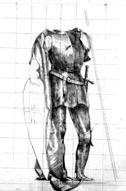|

Comment
on this story
What:
Victorian Visionary: The Art of Elliott Daingerfield
Where:
The Knoxville Museum of Art, 1050 World's Fair Park Drive, 525-6101
When:
Friday, Oct. 18 - Jan. 5, 2003
|
|

The quest of painter Elliott Daingerfield
by Heather Joyner
In October of 1859, the father of artist Elliott Daingerfield found himself in quite a predicament when the Harper's Ferry, Va., arsenal he was responsible for was raided by anti-slavery crusader John Brown. Meanwhile, his wife was home giving birth to a son who would one day hobnob with northeastern socialites, recounting his father's rescue by Robert E. Lee.
Long after that incident and Brown's hanging, Elliott wrote in his journal, "it is always a pleasure to me to know that when Colonel Lee came with government troops to quell that [up]rising, he made my father's house his headquarters and I was many times in his arms, being the baby of the family." But the younger Daingerfield's first memories were of Fayetteville, N. C., where he would survive the Civil War and live with his family until moving to New York City at the age of 21. Beginning tomorrow, the KMA presents a plethora of Daingerfield images, and we are left to ponder his place in history. �
Once in Manhattan, Daingerfield wasted no time getting down to work as a painter. In 1880, his options for study were many, as the United States could boast almost 30 art schools (whereas seven years earlier only a few such institutions existed). The time was ripe. Unfortunately, dominant movements were a bit overripe, and Daingerfield took to Symbolism and Tonalism like a fly to pecan pie.
Writes art historian Shearer West, "The fact that it is almost impossible to describe or convey the meaning of Symbolist works even today is not a failure on the part of art historians, but rather a result of the obscurantist intentions of the artists who produced them." In other words, we can't judge whether or not the emperor is wearing clothes if he won't emerge from the dressing room. We're not even sure who the emperor is. As for Tonalism, ne'er was an art fad so moodily poetic, which is fine if one prefers Carpenters' lyrics to Walt Whitman. Combined with Daingerfield's fresh-from-the-ailing-South enthusiasm and religious fervor, the above movements proved a recipe for artistic befuddlement and occasional schlock. Which brings us to the KMA's new show.
Featuring numerous oil canvases, watercolors, and drawings, Victorian Visionary reflects a late 19th century desire to acknowledge "the inner life" as only the materially privileged could. It also promotes the notion that imitation of European academic art was a good thing. And good it was, if one wants—as Daingerfield did in his painting "The Sleepers" (1914)—to place a version of Titian's "Venus of Urbino" in a scene that suggests an orgy cut short by food poisoning. Another sultry nude, this time lounging on even sleazier-looking satin, is positioned in front of a view of the Grand Canyon. It's enough to make one head for I-40. Fast.
The above might be forgivable if the Daingerfield images on view were from a lesser collection, but I get the feeling that pieces on loan from Georgia's Morris Museum of Art are considered the cream of the crop. And in the style of Albert Pinkham Ryder, one of his great influences, Daingerfield applies pigment with so much gusto that it often becomes a murky mess. His "A Fantasy" is overworked, yet oddly incomplete. What appears to be a sunny side-up egg adhered to the painting hovers above a pair of gangly swans beside a standing figure. "Neptune's Daughter," with its naked boy amidst ocean waves clutching the beard of a Moses-type figure, is perplexing and similarly overdone. Of the "epic" canvases, only 1893's "The Mystic Brim" possesses a subtlety fitting its ethereal subject matter. As for Daingerfield's poetry (from which lines are drawn to accompany numerous images), the Carpenters again come to mind.
It seems that Daingerfield's more "casual" works are the ones that shine. A 1910 watercolor of North Carolina's Grandfather Mountain is memorable—painted when the artist was dividing his time between Blowing Rock and his Manhattan studio. His painting "Sunset Glory" (1915), despite heavy paint, is lovely as well. Its ambered landscape with a small, soft fir among spindly trees hints at nature's vulnerability. It needs no grandiose classical or visionary allusions. Shame is, neither did Daingerfield.

October 17, 2002 * Vol. 12, No. 42
© 2002 Metro Pulse
|